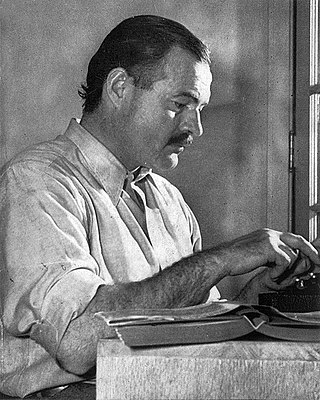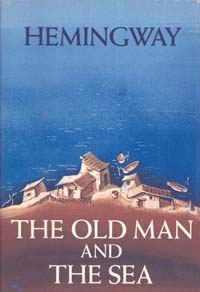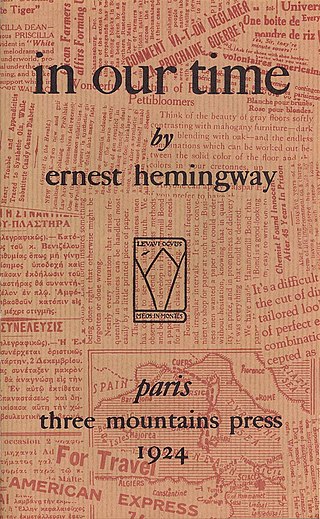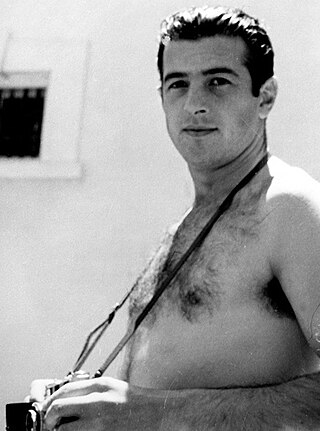
Ernest Miller Hemingway was an American novelist, short-story writer and journalist. Best known for an economical, understated style that significantly influenced later 20th-century writers, he is often romanticized for his adventurous lifestyle, and outspoken and blunt public image. Most of Hemingway's works were published between the mid-1920s and mid-1950s, including seven novels, six short-story collections and two non-fiction works. His writings have become classics of American literature; he was awarded the 1954 Nobel Prize in Literature, while three of his novels, four short-story collections and three nonfiction works were published posthumously.

For Whom the Bell Tolls is a novel by Ernest Hemingway published in 1940. It tells the story of Robert Jordan, a young American volunteer attached to a Republican guerrilla unit during the Spanish Civil War. As a dynamiter, he is assigned to blow up a bridge during an attack on the city of Segovia.

The Old Man and the Sea is a 1952 novella written by the American author Ernest Hemingway. Written between December 1950 and February 1951, it was the last major fictional work Hemingway published during his lifetime. It tells the story of Santiago, an aging fisherman, and his long struggle to catch a giant marlin. The novella was highly anticipated and was released to record sales; the initial critical reception was equally positive, but attitudes have varied significantly since then.

Anisette, or Anis, is an anise-flavored liqueur that is consumed in most Mediterranean countries. It is colorless and, because it contains sugar, is sweeter than dry anise flavoured spirits. The most traditional style of anisette is that produced by means of distilling aniseed, and is differentiated from those produced by simple maceration by the inclusion of the word distilled on the label. And while Pastis is a similar-tasting liqueur that is prepared in similar fashion and sometimes confused with anisette, it employs a combination of both aniseed and licorice root extracts. Sambuca is essentially an anisette of Italian origin that requires a high minimum (350g/L) sugar content.

The Sun Also Rises is the first novel by the American writer Ernest Hemingway. It portrays American and British expatriates who travel along the Camino de Santiago from Paris to the Festival of San Fermín in Pamplona and watch the running of the bulls and the bullfights. An early modernist novel, it received mixed reviews upon publication. Hemingway biographer Jeffrey Meyers writes that it is now "recognized as Hemingway's greatest work" and Hemingway scholar Linda Wagner-Martin calls it his most important novel. The novel was published in the United States in October 1926 by Scribner's. A year later, Jonathan Cape published the novel in London under the title Fiesta. It remains in print.

The Dangerous Summer is a nonfiction book by Ernest Hemingway published posthumously in 1985 and written in 1959 and 1960. The book describes the rivalry between bullfighters Luis Miguel Dominguín and his brother-in-law, Antonio Ordóñez, during the "dangerous summer" of 1959. It has been cited as Hemingway's last book.

Death in the Afternoon is a non-fiction book written by Ernest Hemingway about the history, ceremony and traditions of Spanish bullfighting, published in 1932. It also contains a deeper contemplation on the nature of fear and courage. While essentially a guide book, there are three main sections: Hemingway's work, pictures, and a glossary of terms.

The Garden of Eden is the second posthumously released novel of Ernest Hemingway, published in 1986. Hemingway started the novel in 1946 and worked on the manuscript for the next 15 years, during which time he also wrote The Old Man and the Sea, The Dangerous Summer, A Moveable Feast, and Islands in the Stream.

In Our Time is the title of Ernest Hemingway's first collection of short stories, published in 1925 by Boni & Liveright, New York, and of a collection of vignettes published in 1924 in France titled in our time. Its title is derived from the English Book of Common Prayer, "Give peace in our time, O Lord".

Sobrino de Botín is a Spanish restaurant in Madrid. The artist Francisco de Goya worked in Café Botín as a waiter while waiting to get accepted into the Royal Academy of Fine Arts. The restaurant is mentioned in an Ernest Hemingway novel and the book Fortunata y Jacinta by Benito Pérez Galdós. It is the oldest operating restaurant in the world.

Antonio Ordóñez Araujo was a Spanish bullfighter.

Dateline: Toronto is a collection of most of the stories that Ernest Hemingway wrote as a stringer and later staff writer and foreign correspondent for the Toronto Star between 1920 and 1924. The stories were written while he was in his early 20s before he became well-known, and show his development as a writer. The collection was edited by William White, a professor of English literature and journalism at Wayne State University, and a regular contributor to The Hemingway Review.

The Sun Also Rises is a 1957 American drama film adaptation of the 1926 Ernest Hemingway novel of the same name directed by Henry King. The screenplay was written by Peter Viertel and it starred Tyrone Power, Ava Gardner, Mel Ferrer, and Errol Flynn. Much of it was filmed on location in France and Spain as well as Mexico in Cinemascope and color by Deluxe. A highlight of the film is the famous "running of the bulls" in Pamplona, Spain and two bullfights.

Ernest Hemingway (1899–1961) was an American novelist, short-story writer, journalist, and sportsman. His economical and understated style—which he termed the iceberg theory—had a strong influence on 20th-century fiction. Many of his works are considered classics of American literature.

Hotel La Perla is a five-star hotel in Pamplona, Spain and is located in the Plaza del Castillo, with one side facing Estafeta Street, one of the main routes in the Running of the Bulls. The balconies of the hotel are among the most coveted sites from which to view the event.
The Sun Also Rises is a 1984 television miniseries adaptation of Ernest Hemingway's 1926 novel The Sun Also Rises. Hart Bochner, Jane Seymour, Robert Carradine, Ian Charleson and Leonard Nimoy have starring roles. It aired on NBC on Sunday, December 9, and Monday, December 10, from 9–11 pm.
The Sun Also Rises is a one-act opera by Webster A. Young, based on Ernest Hemingway's 1926 novel The Sun Also Rises. It is one of a pair of Hemingway works that Young adapted into operas. The opera's libretto is by the composer, and includes direct quotations from the novel. It premiered on May 7, 2000, at the Long Island Opera.

The Sun Also Rises or Hemingway: The Sun Also Rises is a 2013 ballet adaptation of Ernest Hemingway's 1926 novel The Sun Also Rises that was premiered by The Washington Ballet at The Kennedy Center under Artistic Director Septime Webre, whose parents had known Hemingway. It is the first version of this work en pointe. It premiered from May 8 – 12, 2013. Webre had previously adapted The Great Gatsby and Alice in Wonderland to ballet. According to Emily Cary of The Washington Examiner, like the source, the plot is about "a group of American and British expatriates who meet in Paris and travel to Pamplona, Spain, to watch the running of the bulls and the bullfights." Clark notes that the production was inspired by one of Webre's friends who taught American literature at Yale University who suggested an adaptation.

The Select (The Sun Also Rises) is a stage adaptation of Ernest Hemingway's 1926 novel The Sun Also Rises by Elevator Repair Service theater ensemble. It has been performed in several venues. It premiered at the 2010 Edinburgh Festival Fringe. The Off-Broadway production, which ran from September 11 – October 23, 2011 at the New York Theatre Workshop (NYTW), earned awards for its sound design. The show directed by John Collins and produced by Ariana Smart Truman and Lindsay Hockaday received the Lucille Lortel Award for being outstanding.





















